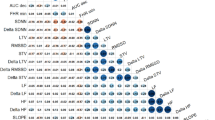Abstract
Non-reassuring fetal heart rate tracings reflect an imbalance between the parasympathetic and sympathetic nervous systems. In this situation, fetal asphyxia can be suspected and may be confirmed by metabolic measurements at birth like low pH or high base deficit values. The objective of this study was to determine whether fetal asphyxia during labor is related to parasympathetic nervous system activity. This is a retrospective study of a database collected in 5 centers. Two hundred and ninety-nine fetal heart rate tracings collected during labor were analyzed. Autonomic nervous system, especially the parasympathetic nervous system, was analyzed using an original index: the FSI (Fetal Stress Index). The FSI is a parasympathetic activity evaluation based on fetal heart rate variability analysis. Infants were grouped based on normal or low pH value at birth. FSI was measured during the last 30 min of labor before birth and compared between groups. The minimum value of the FSI during the last 30 min before delivery was significantly lower in the group with the lower umbilical cord arterial pH value. In this pilot study during labor, FSI was lower in the group of infants with low arterial pH at birth.

Similar content being viewed by others
References
MacLennan A. A template for defining a causal relation between acute intrapartum events and cerebral palsy: international consensus statement. BMJ. 1999;319:1054–9.
Mwaniki MK, Atieno M, Lawn JE, Newton CR. Long-term neurodevelopmental outcomes after intrauterine and neonatal insults: a systematic review. Lancet. 2012;379:445–52.
Durosier LD, Green G, Batkin I, Seely AJ, Ross MG, Richardson BS, Frasch MG. Sampling rate of heart rate variability impacts the ability to detect acidemia in ovine fetuses near-term. Front Pediatr. 2014;2:38.
Williams KP, Galerneau F. Intrapartum fetal heart rate patterns in the prediction of neonatal acidemia. Am J Obstet Gynecol. 2003;188:820–3.
Soncini E, Paganelli S, Vezzani C, Gargano G, Giovanni Battista LS. Intrapartum fetal heart rate monitoring: evaluation of a standardized system of interpretation for prediction of metabolic acidosis at delivery and neonatal neurological morbidity. J Matern Fetal Neonatal Med. 2014;27:1465–9.
Ayres-de-Campos D, Spong CY, Chandraharan E. FIGO consensus guidelines on intrapartum fetal monitoring: cardiotocography. Int J Gynaecol Obstet. 2015;131:13–24.
American College of Obstetricians and Gynecologists. Practice bulletin no. 116: Management of intrapartum fetal heart rate tracings. Obstet Gynecol. 2010;116:1232–1240.
Royal College of Obstetricians and Gynaecologists. The use of electronic fetal monitoring. The use of cardiotocography in intrapartum fetal surveillance. Evidence-based Clinical Guideline Number 8. Clinical Effectiveness Support Unit. 2001.
Gagnon R, Campbell MK, Hunse C. A comparison between visual and computer analysis of antepartum fetal heart rate tracings. Am J Obstet Gynecol. 1993;168:842–7.
Blackwell SC, Grobman WA, Antoniewicz L, Hutchinson M, Gyamfi BC. Interobserver and intraobserver reliability of the NICHD 3-tier fetal heart rate interpretation system. Am J Obstet Gynecol. 2011;205:378–500.
Rhose S, Heinis AM, Vandenbussche F, van Drongelen J, van Dillen J. Inter- and intra-observer agreement of non-reassuring cardiotocography analysis and subsequent clinical management. Acta Obstet Gynecol Scand. 2014;93:596–602.
Li X, Tang D, Zhou S, Zhou G, Wang C, Zhuang Y, Wu G, Shen L. Redistribution of power spectrum of heart rate variability during acute umbilical artery embolism and hypoxemia in late-gestation fetal sheep. Eur J Obstet Gynecol Reprod Biol. 2004;114:137–43.
Frasch MG, Muller T, Weiss C, Schwab K, Schubert H, Schwab M. Heart rate variability analysis allows early asphyxia detection in ovine fetus. Reprod Sci. 2009;16:509–17.
Kwon JY, Park IY, Shin JC, Song J, Tafreshi R, Lim J. Specific change in spectral power of fetal heart rate variability related to fetal acidemia during labor: comparison between preterm and term fetuses. Early Hum Dev. 2012;88:203–7.
van Laar JO, Peters CH, Vullings R, Houterman S, Bergmans JW, Oei SG. Fetal autonomic response to severe acidaemia during labour. BJOG. 2010;117:429–37.
Annunziata ML, Tagliaferri S, Esposito FG, Giuliano N, Mereghini F, Di LA, Campanile M. Computerized analysis of fetal heart rate variability signal during the stages of labor. J Obstet Gynaecol Res. 2016;42:258–65.
Jeanne M, Clement C, De Jonckheere J, Logier R, Tavernier B. Variations of the analgesia nociception index during general anaesthesia for laparoscopic abdominal surgery. J Clin Monit Comput. 2012;26:289–94.
Gruenewald M, Ilies C, Herz J, Schoenherr T, Fudickar A, Hocker J, Bein B. Influence of nociceptive stimulation on analgesia nociception index (ANI) during propofol-remifentanil anaesthesia. Br J Anaesth. 2013;110:1024–30.
Boselli E, Daniela-Ionescu M, Begou G, Bouvet L, Dabouz R, Magnin C, Allaouchiche B. Prospective observational study of the non-invasive assessment of immediate postoperative pain using the analgesia/nociception index (ANI). Br J Anaesth. 2013;111:453–9.
Le Guen M, Jeanne M, Sievert K, Al MM, Chazot T, Laloe PA, Dreyfus JF, Fischler M. The Analgesia Nociception Index: a pilot study to evaluation of a new pain parameter during labor. Int. J. Obstet. Anesth. 2012;21:146–51.
Rommel D, Nandrino JL, De Jonckheere J, Swierczek M, Dodin V, Logier R. Maintenance of parasympathetic inhibition following emotional induction in patients with restrictive type anorexia nervosa. Psychiatry Res. 2015;225:651–7.
Faye PM, De Jonckheere J, Logier R, Kuissi E, Jeanne M, Rakza T, Storme L. Newborn infant pain assessment using heart rate variability analysis. Clin J Pain. 2010;26:777–82.
De Jonckheere J, Rakza T, Logier R, Jeanne M, Jounwaz R, Storme L. Heart rate variability analysis for newborn infants prolonged pain assessment. Conf Proc IEEE Eng Med Biol Soc. 2011;2011:7747–50.
Alexandre C, De Jonckheere J, Rakza T, Mur S, Carette D, Logier R, Jeanne M, Storme L. Impact of cocooning and maternal voice on the autonomic nervous system activity in the premature newborn infant. Arch Pediatr. 2013;20:963–8.
van Laar JO, Porath MM, Peters CH, Oei SG. Spectral analysis of fetal heart rate variability for fetal surveillance: review of the literature. Acta Obstet Gynecol Scand. 2008;87:300–6.
Salamalekis E, Hintipas E, Salloum I, Vasios G, Loghis C, Vitoratos N, Chrelias Ch, Creatsas G. Computerized analysis of fetal heart rate variability using the matching pursuit technique as an indicator of fetal hypoxia during labor. J Matern Fetal Neonatal Med. 2006;19(3):165–9.
Malliani A, Pagani M, Lombardi F, Cerutti S. Cardiovascular neural regulation explored in the frequency domain. Circulation. 1991;84:482–92.
Akselrod S, Gordon D, Ubel FA, Shannon DC, Berger AC, Cohen RJ. Power spectrum analysis of heart rate fluctuation: a quantitative probe of beat-to-beat cardiovascular control. Science. 1981;213:220–2.
Heart rate variability. Standards of measurement, physiological interpretation, and clinical use. Task Force of the European Society of Cardiology and the North American Society of Pacing and Electrophysiology. Eur Heart J. 1996;17:354–81.
Malik M, Camm AJ. Components of heart rate variability–what they really mean and what we really measure. Am J Cardiol. 1993;72:821–2.
Chung DY, Sim YB, Park KT, Yi SH, Shin JC, Kim SP. Spectral analysis of fetal heart rate variability as a predictor of intrapartum fetal distress. Int J Gynaecol Obstet. 2001;73:109–16.
Siira SM, Ojala TH, Vahlberg TJ, Jalonen JO, Valimaki IA, Rosen KG, Ekholm EM. Marked fetal acidosis and specific changes in power spectrum analysis of fetal heart rate variability recorded during the last hour of labour. BJOG. 2005;112:418–23.
van Laar JO, Peters CH, Houterman S, Wijn PF, Kwee A, Oei SG. Normalized spectral power of fetal heart rate variability is associated with fetal scalp blood pH. Early Hum Dev. 2011;87:259–63.
Kitlinski ML, Kallen K, Marsal K, Olofsson P. Gestational age-dependent reference values for pH in umbilical cord arterial blood at term. Obstet Gynecol. 2003;102:338–45.
Hanson M, Kumar P. Chemoreceptor function in the fetus and neonate. Adv Exp Med Biol. 1994;360:99–108.
Doret M, Constans A, Gaucherand P. Physiologic basis for fetal heart rate analysis during labour. J Gynecol Obstet Biol Reprod (Paris). 2010;39:276–83.
Sheen TC, Lu MH, Lee MY, Chen SR. Nonreassuring fetal heart rate decreases heart rate variability in newborn infants. Ann Noninvasive Electrocardiol. 2014;19:273–8.
van Laar, J. Fetal autonomic cardiac response during pregnancy and labour. 2012. Thesis.
Romano M, Iuppariello L, Ponsiglione AM, Improta G, Bifulco P, Cesarelli M. Frequency and time domain analysis of foetal heart rate variability with traditional indexes: a critical survey. Comput Math Methods Med. 2016;2016:9585431.
Ayres-de-Campos D, Costa-Santos C, Bernardes J. Prediction of neonatal state by computer analysis of fetal heart rate tracings: the antepartum arm of the SisPorto multicentre validation study. Eur J Obstet Gynecol Reprod Biol. 2005;118:52–60.
Galazios G, Tripsianis G, Tsikouras P, Koutlaki N, Liberis V. Fetal distress evaluation using and analyzing the variables of antepartum computerized cardiotocography. Arch Gynecol Obstet. 2010;281:229–33.
Acknowledgements
We acknowledge all the medical staff who participated to the data collection: Monaco maternity (Valenciennes, France), Saint Vincent-de-Paul hospital (Lille, France), Jeanne de Flandre maternity (Lille, France), Poissy-Saint-Germain hospital (Poissy, France) and Robert-Debré hospital (Paris, France).
Author information
Authors and Affiliations
Corresponding author
Ethics declarations
Conflict of interest
JDJ and RL are shareholders and LB was a team member of Mdoloris Medical Systems (that commercializes ANI and NIPE monitors which are based on the presented technology). The remaining authors report no conflict of interest.
Ethics approval
The present retrospective study was approved by the French committee of obstetrics and gynaecology research ethics (CEROG OBS 2015-11-18).
Rights and permissions
About this article
Cite this article
Butruille, L., De jonckheere, J., Flocteil, M. et al. Parasympathetic tone variations according to umbilical cord pH at birth: a computerized fetal heart rate variability analysis. J Clin Monit Comput 31, 1197–1202 (2017). https://doi.org/10.1007/s10877-016-9957-y
Received:
Accepted:
Published:
Issue Date:
DOI: https://doi.org/10.1007/s10877-016-9957-y




